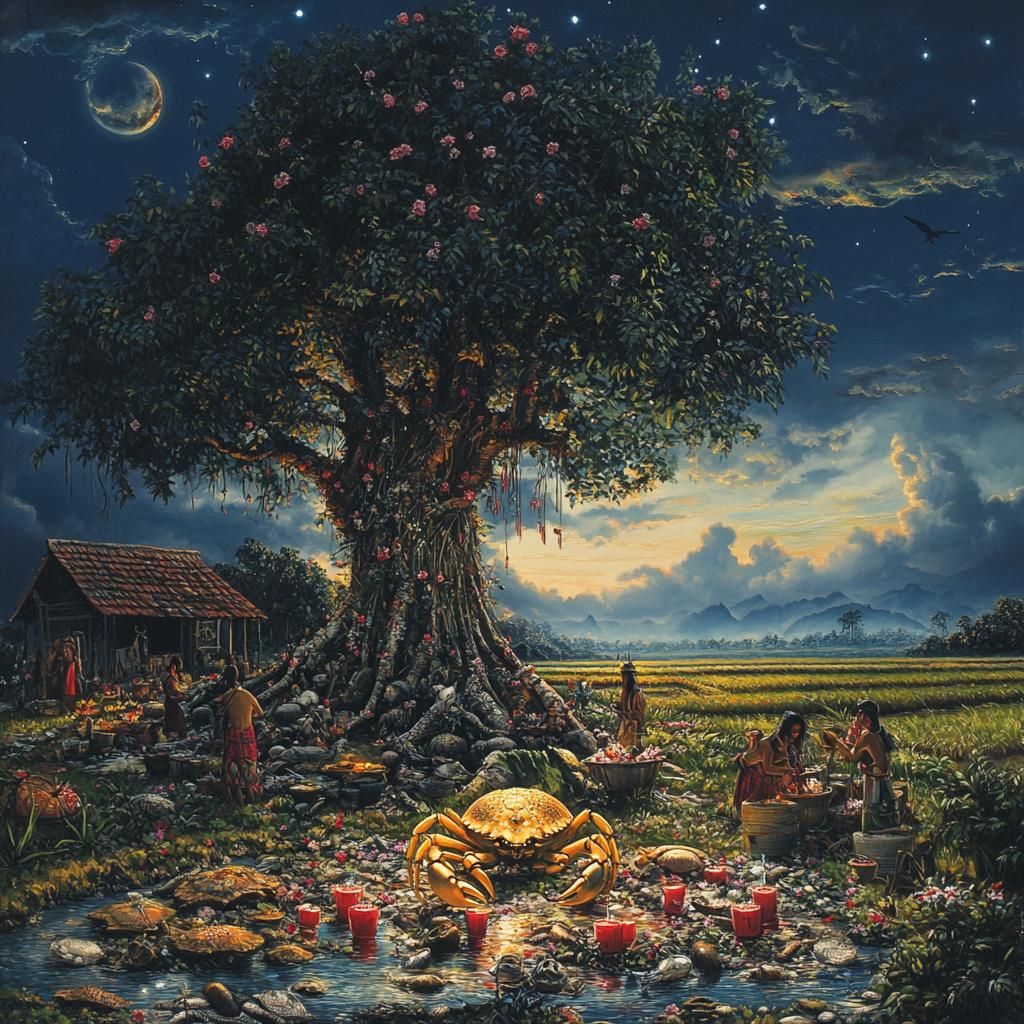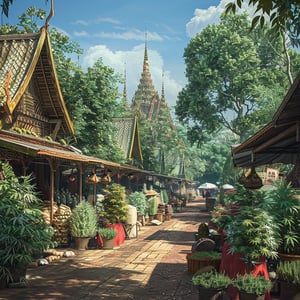As darkness falls over Nong Sai village, a sense of anticipation fills the air. Residents eagerly gather around an ancient neem tree, its history stretching back over a century, nestled beside an abandoned house at the edge of the rice fields. It’s a Buddhist holy day, February 26th to be precise, and the villagers believe this spiritual occasion could bring them good fortune in the upcoming lottery draw.
The neem tree stands tall, its bark aged and wise, embraced by the shared memories of the community. Flowers, incense, brightly burning candles, and a scattering of red drinks form a sacred offering at its base. This ritual is not just tradition; it’s a hopeful plea for the spirits to reveal promising numbers. With respectful reverence, the villagers begin by lighting incense, a signal to the spirits that they’re seeking guidance. The careful scraping of the bark follows, the villagers’ eyes squinting in concentration, waiting for the powdered surface to reveal the elusive numbers that might bring them wealth.
Among the gathered, a 47-year-old resident named Lone shares tales as old as the tree itself. “It’s been here since my birth,” he says, gesturing to the neem tree, its trunk wide enough to require the embrace of four people. Lone talks about how the house nearby is no more than a ghost now, unlived-in for over two decades after its owner passed away at an impressive 84 years. Crumbling in the grip of time, it stands as a solemn reminder of past lives and stories long told.
The process yields numbers like gifts from the universe: 5211, seen in parts as 521, 211, 52, and 11, along with the enigma of the house number, 120. Cameras and smartphones capture these potential talismans of luck, ready to be immortalized in lottery tickets for the government draw on March 1st. A ripple of hopeful energy rises among the villagers, dreams of jackpot stardom dancing in their minds.
But the whisper of fortune isn’t just confined to Surin province. Up in Phayao, curiosity and excitement are bubbling over the discovery of a golden crab caught by a local fisherman. This unusual crustacean, with its dazzling hue, seems a portent straight from a fairy tale, spreading delight throughout its community. Measuring a modest 3.2 cm in length and 2.8 cm in width, the crab’s striking appearance amidst ordinary catches sparked whispers of mysterious numbers marking its belly, possibly hinting at luck yet to unfold.
The golden crab and the ancient neem tree embody a common thread of magic and wonder that runs through these communities. Whether it’s the spirits speaking through tree bark or nature delivering a glittering crab, the pursuit of fortune weaves dreams and hopes tightly into the fabric of life in these villages. As the lottery date approaches, anticipation builds—not just for a win but for stories that continue to thread through the hearts of those who believe.


















I think these rituals are just superstitious nonsense. There’s no magic number hiding in tree barks or the belly of a crab.
It may seem like nonsense to you, but it brings hope and joy to these communities. Plus, who are we to dismiss what they believe in?
Hope is good, but what about when they don’t win? Doesn’t it make them more disappointed?
I think it depends on what they value more—the process or the outcome.
Let’s not forget cultural traditions have a lot of historical significance, even if we don’t understand them fully.
I think it’s fascinating. These rituals show how interconnected humans are with nature and their beliefs. It’s almost poetic.
Poetic, sure, but does it actually do any good? Or is it just a distraction from the real problems these communities face?
Even if it’s just a momentary escape, isn’t that valuable in and of itself?
Does anyone else think that golden crab could be a scientific discovery worth looking into?
Absolutely! Such unusual pigmentation could open up new studies in marine biology.
It might just be a genetic variation, but either way, it’s cool to see how excited the community is about it.
Why not just enjoy these stories for what they are? Not everything needs to be dissected or debunked.
I’ve always believed in the power of positive thinking and intention. Whether it’s numbers on a tree or a sparkling crab, it’s about the energy you put out into the world.
If the village wants to believe in these legends, let them. But let’s focus on more pragmatic solutions like education and community development.
Why are these people wasting their time with ancient trees and crabs when they could be focusing on real, tangible solutions?
I love this blend of mysticism and reality. It’s a reminder of how rich human culture can be.
Isn’t it incredible how we only truly pay attention to nature when we think it has something to offer us, like lottery numbers?
I think these traditions are a testament to human creativity and our never-ending quest for meaning.
Are there any records of people actually winning big from such rituals? Or is it all anecdotal?
Whether or not someone has actually won big, I think it’s about the stories themselves that carry value.
I just hope that if they win, they invest back into the community for lasting change.
Man, if only getting rich was as easy as finding a magic crab!
I read about the golden crab and thought it was like a Pokémon in real life!
It’s nice to dream, but wouldn’t it be more effective to work on feasible goals like better education or healthcare?
What harm is there in a little bit of dreaming and hoping for good luck? The world could use more whimsy.
I get what you’re saying, Ray, but sometimes realistic planning beats whimsy.
As bizarre as it might sound, I kinda love these stories. Anything that keeps hope alive in tough times is worth celebrating.
I’m curious if they’ll keep the crab or release it back? It could bring them more than just lottery luck.